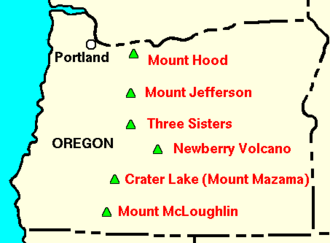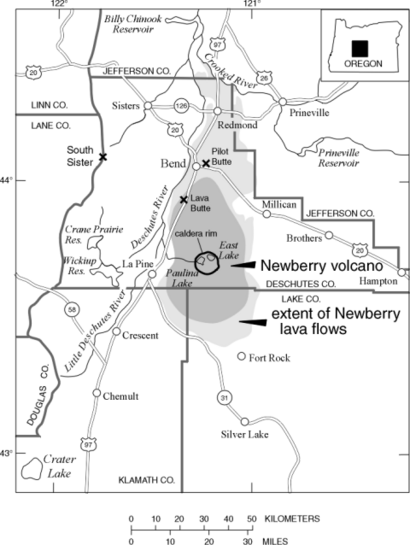Newberry Volcano facts for kids
Quick facts for kids Newberry Volcano |
|
|---|---|

Newberry Caldera, with Paulina Lake, East Lake, and Big Obsidian Flow.
|
|
| Highest point | |
| Elevation | 7,989 ft (2,435 m) |
| Geography | |
| Location | Deschutes County, Oregon, U.S. |
| Parent range | Cascade Range |
| Topo map | USGS Paulina Peak |
| Geology | |
| Age of rock | About 600,000 years old |
| Mountain type | Characteristics of both shield volcanoes and composite volcanoes |
| Volcanic arc | Cascade Volcanic Arc |
| Last eruption | 690 AD |
| Climbing | |
| Easiest route | Road to Paulina Peak |
| Designated: | 1976 |
The Newberry Volcano is a huge, active volcano. It is located about 20 miles south of Bend, Oregon, in the United States. This volcano is part of the Newberry National Volcanic Monument. Its highest point is called Paulina Peak.
Newberry is the largest volcano in the Cascade Volcanic Arc. It covers an area of about 1,200 square miles. This is roughly the same size as the state of Rhode Island. The volcano is about 75 miles long and 27 miles wide. It was named after John Strong Newberry, a geologist who explored central Oregon in 1855. Native American people have lived in this area for over 10,000 years.
The volcano has a large bowl-shaped crater called the Newberry Caldera. This caldera is about 4 by 5 miles wide. Inside it are two lakes: Paulina Lake and East Lake. Newberry Volcano has over 400 vents, which are openings where lava or gas can escape. This is more than any other volcano in the United States. The area has a dry climate with little rain.
Scientists are still learning how Newberry Volcano formed. Most evidence suggests it was created by tectonic plates crashing together. This happened when the Juan de Fuca and Gorda plates slid under the North American Plate. Newberry Volcano started erupting about 600,000 years ago. Its last eruption was about 1,300 years ago. Unlike many shield volcanoes, Newberry has erupted different types of lava.
Newberry Volcano is a popular spot for outdoor activities. People enjoy hiking, fishing, and boating here. It is still considered an active volcano. This means it could erupt again in the future. Eruptions could cause lava flows, ashfall, and mudslides. Scientists closely watch the volcano with special sensors. This helps them track any changes.
Contents
Exploring Newberry Volcano
Newberry Volcano is located in central Oregon. It sits where Deschutes, Klamath, and Lake counties meet. It's one of the easiest volcanoes to visit in Oregon. Newberry is the biggest volcano in the Cascade Volcanic Arc. It rises about 3,500 feet above the land around it. Because it's so big, people sometimes think it's an entire mountain range.
The climate around Newberry is very dry. This is because the Cascade Range blocks most of the rain. Summer temperatures usually range from 73 to 82 degrees Fahrenheit. Winters are cold, with temperatures from -18.8 to 20.5 degrees Celsius. Even with heavy rain, water rarely runs off the surface. There is only one stream on the volcano.
Scientists are not sure if glaciers ever covered Newberry. Some signs suggest they might have. For example, large rocks moved far from their original spots. Also, some cone shapes look like glaciers changed them. Dry channels and waterfalls show that water once flowed here.
The Crater Lakes
Newberry Volcano has two lakes inside its caldera. These are Paulina Lake and East Lake. Rain and groundwater fill these lakes. Paulina Lake is about 1,530 acres big and 250 feet deep. A narrow strip of land separates it from East Lake. This land is made of hardened lava. East Lake is smaller, about 1,050 acres, and 180 feet deep.
These lakes have caused floods in the past. A big flood happened between 4,000 and 2,300 years ago. It released a lot of water from Paulina Lake. This flood filled the valley below the lake. It might have been caused by a rock ledge breaking. Another flood occurred in 1909 on the Deschutes River.
Plants and Animals
The Newberry National Volcanic Monument has unique soil. It's made of volcanic ash and rock over basalt. Forests here include juniper, whitebark pine, and ponderosa pine trees. You can also find lodgepole pine and white fir. Other plants like Indian paintbrush and manzanita grow here.
Sadly, tiny bugs called mountain pine beetles have killed many lodgepole pines. Many animals live near Newberry Volcano. These include burrowing owls, kangaroo rats, and lizards. You might also spot bats, rattlesnakes, and eagles. Larger animals like porcupines, otters, and bobcats live here too. Mule deer and Roosevelt elk also call this area home.
Different lava flows have different amounts of plants. Generally, more plants grow at higher elevations. Common plants on lava flows include oceanspray and wax currant. Rabbitbrush is also often seen. Grasses like Idaho fescue grow in patches. One lava flow at Lava Butte has mostly greenleaf manzanita.
The Lava Cast Forest is a special place. It has tree shapes made by lava from an eruption 6,000 years ago. The lava flowed around the trees, cooled, and left their molds. This area is part of the Newberry National Volcanic Monument. It has islands of untouched forest. These forests have ponderosa pine and lodgepole pine trees.
How Newberry Volcano Formed
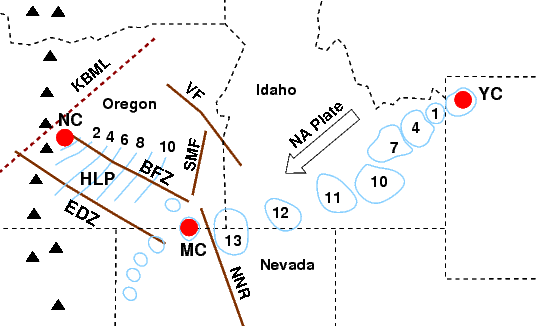
KBML = Klamath–Blue Mountains Lineament
HLP = High Lava Plains
EDZ = Eugene–Denio Zone
BFZ = Brothers Fault Zone
SMF = Steens Mountain Fault
VF = Vale Fault
NNR = North Nevada Rift
White arrow shows direction of North American plate. Edge of the craton is approximately along the Oregon–Idaho border. Triangles are Cascades volcanoes.
Newberry Volcano sits in a region with many faults. These are cracks in the Earth's crust. It's located where several fault zones meet. Underneath Newberry, the Earth's crust is thinner than in other places. This might explain why its magma is special.
Newberry Volcano started forming about 600,000 years ago. It has grown from thousands of eruptions since then. About 500,000 years ago, Mount Newberry was very tall, around 14,000 feet. The big caldera at its top formed about 75,000 years ago. This happened during a huge explosive eruption. This event created the crater lakes and Paulina Peak. Paulina Peak is now the highest point on the volcano.
Newberry is a mix of two volcano types. It has the wide, flat shape of a shield volcano. But it also has layers of lava and ash, like a composite volcano. This is why it's often called a "shield-shaped composite volcano." The caldera at its top is about 4 by 5 miles wide. It has the two crater lakes, Paulina Lake and East Lake. The caldera has changed shape many times over the volcano's history.
Volcano Features

Newberry Volcano has over 400 vents. These are openings where lava or ash can come out. This is more than any other volcano in the United States. These vents include cinder cones and lava domes. At least 25 vents have been active in the last 10,000 years. Many cinder cones are 200 to 400 feet tall. Some are even taller than 500 feet.
About 7,000 years ago, lava fountains erupted from a long crack. This created basaltic and andesitic lava flows. Strombolian eruptions also formed Lava Butte. Lava Butte is a cinder cone about 500 feet tall. It sits 10 miles south of Bend.
Hot springs are found at Paulina Lake and East Lake. There is also a gas vent called a fumarole at Lost Lake. These release hot water vapor and carbon dioxide. They can smell like rotten eggs, but the gases are mostly harmless.
Newberry's Eruptive History
In the past, Newberry Volcano produced huge lava flows. These basaltic flows came from its northern side. They reached areas where Bend and Redmond are today. Lava from an eruption 78,000 years ago covered the Bend area. It also filled the Deschutes River bed.
Newberry has also had powerful explosive eruptions. Some were like the eruption of Vesuvius that destroyed Pompeii. These eruptions sent ash high into the sky. Ash from one eruption covered thousands of square miles. It reached as far as the San Francisco Bay Area in California. That's almost 500 miles away!
Between 12,000 and 7,700 years ago, Newberry erupted at least 12 times. About 7,700 years ago, Mount Mazama erupted. Its ash and pumice covered Newberry Volcano up to 6 feet deep. Over the last 7,500 years, the caldera has had rhyolitic eruptions from seven vents. About 7,000 years ago, eruptions created 12 lava flows. These covered an area of 23 square miles.
The volcano's most recent eruptions happened 1,300 years ago. These created the Big Obsidian flow. This flow is made of a type of volcanic glass called obsidian. It's one of the largest obsidian formations in the United States. The eruption started with a big explosion of pumice and ash. This ash reached hundreds of miles to the east. Strong winds carried the ash as far as Idaho. This eruption also sent volcanic bombs into Paulina Lake.
Future Dangers
Newberry Volcano is currently quiet, but it's still active. Scientists consider it a "very high" threat. Hot springs are still active inside the caldera. Small earthquakes also happen often. Any future eruptions would likely be similar to past ones. They could range from slow lava flows to explosive ash eruptions.
If large lava flows happen again, they could cover towns in Central Oregon. They might also block major roads like U.S. Route 97. This would stop transportation and cause economic problems. Lava flows usually move slowly, about 30 feet per minute. So, people and animals could escape them. But they would destroy buildings and other structures.
Pyroclastic flows are much more dangerous. These are fast-moving clouds of hot gas and ash. They can travel at 20 to 200 miles per hour. They would burn or crush everything in their path. Luckily, pyroclastic flows have been rare at Newberry. Ash from explosive eruptions could also cause problems. It could damage power lines and airplane engines. Ash particles can also irritate eyes and lungs.
If pyroclastic flows mix with water from the lakes, they could create lahars. These are volcanic mudslides. Lahars could rush down valleys and reach towns quickly. Newberry Volcano poses a danger to about 16,400 people living within 30 miles. It also affects over 180,000 people within 100 miles.
Floods can also happen at Newberry. If lava flows block the Deschutes River, they could cause floods. Earthquakes also occur in Oregon. Volcanoes can cause earthquakes up to magnitude 5. These can shake houses but usually don't cause major damage. Scientists believe they would detect signs before a major eruption. Increased earthquakes or volcanic gas would be warning signs.
Scientists closely monitor Newberry Volcano. They use seismometers to detect earthquakes. They also use GPS instruments to check for ground swelling. This swelling could mean magma is moving underground. These monitoring efforts help keep people safe.
Human History at Newberry
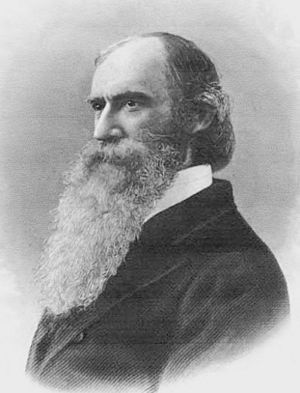
Native American people have lived around Newberry Volcano for over 10,000 years. They sometimes moved away during eruptions. In 1992, archaeologists found signs of an ancient home near Paulina Lake. It was dated to 11,000 years ago. People used the volcano's obsidian (volcanic glass) to make tools. They traded this obsidian all along the Pacific Coast.
The first European to visit the volcano was Peter Skene Ogden in 1826. The volcano is named after John Strong Newberry. He was a geologist who explored central Oregon in 1855. However, he never actually visited the volcano itself. Paulina Lake and Paulina Peak are named after Paulina. She was a Native American chief in the 1850s and 1860s.
In 1963, NASA scientists became interested in Newberry. They used the lava fields to train astronauts for moon landings. Astronauts like Neil Armstrong and Buzz Aldrin trained here. They learned to recognize volcanic features. This training helped them explore the Moon.
The Newberry National Volcanic Monument was created in 1990. It covers over 54,000 acres. It includes the caldera and a long area to the northwest. The Monument is managed by the United States Forest Service. It has campgrounds, resorts, and summer houses.
Geothermal Energy
Newberry Volcano is a good source of geothermal energy. This is because it has recent eruptions and a shallow heat source. Hot springs also show there's heat underground. In 1981, scientists drilled a well over 3,000 feet deep. They found very hot temperatures underground. An energy company drilled deeper in 1995 and 1996. They hoped to find hot water to create electricity. Newberry Volcano is considered the best spot for geothermal energy in the Pacific Northwest.
Fun at Newberry Volcano
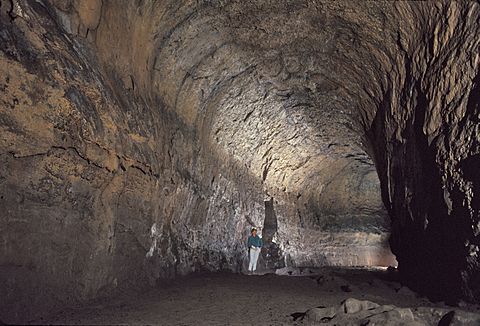
About 250,000 people visit Newberry Volcano each year. Many come to fish for trout in East Lake. Others enjoy camping at Paulina Lake. Mountain biking is popular on the 22-mile loop around the crater. The lakes are also great for boating.
At the Newberry National Volcanic Monument, you can camp, fish, and hike. The Trail of the Molten Land follows a 7,000-year-old lava flow. The Trail of the Whispering Pines goes through a ponderosa pine forest. You can also go horse riding on a part of the Peter Skene Ogden Trail. In winter, snowmobiling and cross-country skiing are popular.
The Lava Lands Visitor Center teaches about the area's geology. It has a paved path that is 5.5 miles long. A shuttle takes visitors to the area during peak season. You can also drive your own car with a permit. The visitor center's parking lot is open all year. There are eight campgrounds managed by the Forest Service.
The Lava River Cave is a popular attraction. It's about 12 miles south of Bend. This cave is Oregon's longest continuous lava tube. You can hike for over a mile inside it. The cave has high arched ceilings. It's open from May to mid-September. A day pass costs $5. It's a good idea to bring a jacket, as the cave is usually 40 degrees Fahrenheit.
The Lava Cast Forest is another cool spot. It's a group of tree molds made by lava 6,000 years ago. You can see them from a one-mile paved trail. This area became a Geological Area in 1942. Thousands of tourists visited it each year by the 1940s.
You can hike to the volcano's summit at Paulina Peak. The trail is 15.5 miles long from Highway 97. There's an easy paved road to the caldera. The last three miles are gravel and winding. From the top, you can see Mount Hood, Mount McLoughlin, and the Three Sisters volcanoes.


